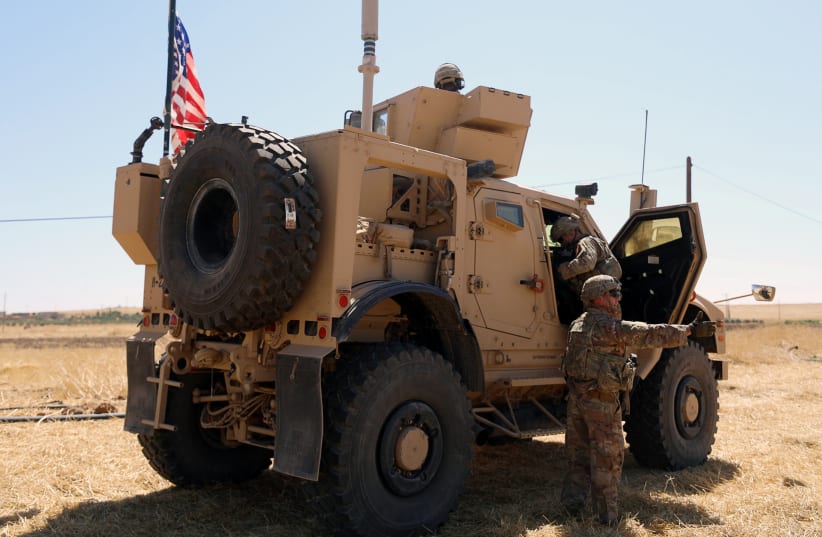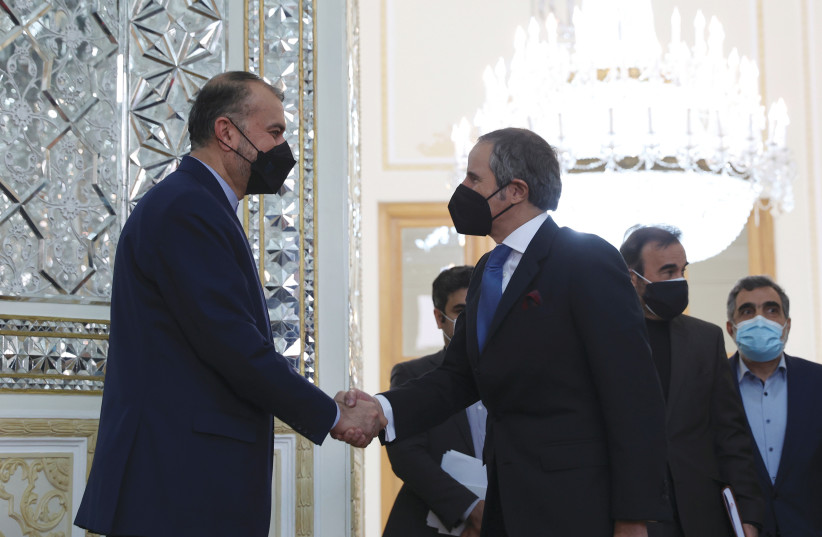Attacks on US forces in Iraq and Syria by pro-Iranian groups using drones represents an emerging threat in the region. The US acknowledged the attacks in a recent report on the US role in Iraq and Syria, the quarterly Lead Inspector General report to the US Congress on Operation Inherent Resolve.
The report covers the October-December 2021 period. These reports usually are released a month or two after they have been provided to US authorities and Congress. The report combines information from the Pentagon, the US State Department, Central Command and other sources.
These reports are important because they provide evidence of the rising Iranian threat in Iraq and Syria against US forces. Over the last several years, Iran and proxy militias it works with have been threatening the US. This began to increase rapidly in May 2019 and resulted in numerous rocket attacks on US forces. Within a year several US personnel and contractors were killed. The US responded with airstrikes.
When President Joe Biden came into office in early 2021, it appeared that the militias began to recalibrate their tactics. The Trump administration had repositioned US forces, withdrawing from a dozen facilities in Iraq and concentrating troops in Baghdad, Ain al-Asad air base and Erbil in the more secure Kurdistan Region.
The changes in posture and the relatively small number of US troops, as well as that the US had ended any combat missions out in the field, meant the Iranian-backed militias had to change tactics.
Iran is discussing a nuclear deal in Vienna, and it is aware that harming US forces in Iraq and Syria could be a setback for its cause. Another factor is that Iran has been moving new technologies to Iraqi-based militias. This includes ballistic missiles and drones, which gives them more capabilities than the 107-mm. and 122-mm. rockets that the militias have used in the past.
These rockets are used by hiding them on a truck or on a launcher and then timing a launch, while the perpetrators disappear. The US has also moved air defenses to Iraq to confront these attacks. These defenses are usually what are known as C-RAM, which can counter rockets.
The militias responsible consist of Kataib Hezbollah and other groups called Popular Mobilization Units. These groups operate closely with Iran’s IRGC. The US killed Kataib Hezbollah leader Abu Mahdi al-Muhanids and IRGC Quds Force leader Qasem Soleimani in January 2020.
THE NEW report contains several mentions of drones and UAVs. It begins by noting the Iranian threat. Operation Inherent Resolve, the coalition to defeat ISIS, “said that Iran-aligned militia groups posed an increased security threat to US and Coalition forces and the OIR mission during the quarter. These actors continued to harass Coalition forces by conducting unmanned aerial vehicle (UAV) and rocket attacks against Coalition bases,” the report said.
On October 20, “five drones laden with explosives target US forces in the vicinity of Al Tanf Garrison [Syria] in a suspected Iran-aligned militia attack,” the report said, adding that “CJTF-OIR [Operation Inherent Resolve] reported that the threat Iranian forces and Iran-aligned militias pose to US military personnel and local partners operating in Syria increased during the quarter. In October, multiple unmanned aerial vehicles (UAV) targeted US forces in the vicinity of the Al Tanf Garrison.”
“CJTF-OIR [the Coalition to defeat ISIS] reported that Iranian forces and Iran-aligned militias posed an increased threat to Coalition personnel and local partners operating in Syria during the quarter,” the report said. “An October 20 attack on Coalition forces operating in the vicinity of the Al Tanf Garrison illustrated this threat. The attack was ‘complex, coordinated, and deliberate,’ according to a USCENTCOM spokesperson. CJTF-OIR assessed that although the attack – which included the use of five Iranian UAVs – was similar to those carried out by Iran-aligned militias elsewhere in the region, it was the most sophisticated strike against Coalition forces in Syria to date.”
It goes on to note that “according to the DIA [Defense Intelligence Agency], Iran-aligned militias conducted at least two other attacks against Coalition forces in Syria in 2021, but they resulted in no casualties.”
The Iraqi prime minister survived an assassination attempt on November 7, the report said, adding: “No group claimed responsibility for the attempted assassination, which included the use of unmanned aerial vehicles (UAV) to attack the prime minister’s residence. The attack followed days of protests over the October election results, led by Iran-aligned militias. Meanwhile, the militias paused attacks on US and Coalition forces during the quarter.”
More details of that attack are provided. “On November 7, Prime Minister al-Kadhimi survived an assassination attempt after two quadcopter UAVs attacked his residence in Baghdad, injuring several guards,” the report said. “The DIA [Defense Intelligence Agency] said no group has claimed responsibility for the attack, but noted the attack followed days of militia-led protests. The DIA also noted that at the November 6 funeral held for the protesters, Qays al-Khazali, the Secretary General of the Iran-aligned militia, Asa’ib Ahl al-Haq, warned the prime minister would be held accountable for their deaths, suggesting that his group possibly conducted the attack.”
Khazali is the head of Asaib Ahl al-Haq and has been sanctioned by the US. He traveled to Lebanon in 2017 and vowed to help Hezbollah threaten Israel.
On December 13, “Coalition aircraft shoots down [a] drone ‘demonstrating hostile intent’ as it was about to enter airspace around the Tanf garrison; a second drone turned around,” the report said.
The US Department of Defense “is conducting an audit to determine whether the Military Services effectively conducted pre-deployment training to counter an adversary’s use of unmanned aircraft systems,” it said.
THIS IS clearly related to the rising threat. Furthermore, the Department of Defense “intends to conduct an audit to determine whether the DoD is implementing effective oversight, controls, and processes to mitigate cybersecurity risks to unmanned systems, including those in the OIR area of responsibility.”
Oddly, the report says in an appendix that this project was “suspended due to COVID-19. The project will restart when force health protection conditions permit.”
It’s not clear why COVID would mean they can’t assess whether they have the right processes to stop UAVs, since UAVs don’t stop attacking during a pandemic. This appears to be a US bureaucratic excuse for not doing this – one of many ways that the pandemic enables governments to not do their job and pretend the “pandemic” is responsible.
The report includes several references to oversight of the need to be up to date about “unmanned” threats, including in pre-deployment phases prior to sending troops abroad. The finding notes the “evaluation of the US Central Command’s Defense of critical assets within its Area of Responsibility Against Missiles and Unmanned Aircraft Systems to determine the extent to which the US Central Command can defend critical assets within its area of responsibility against missile and unmanned aircraft system threats.”
There is also an “Evaluation of Service Capabilities to Counter Unmanned Aircraft Systems,” which is “to determine the extent to which the Military Services have implemented intelligence support and techniques, tactics and procedures necessary to employ counter-unmanned aircraft systems.”
“The Department of State reported that there were no indirect fire attacks on Mission Iraq facilities during the quarter by Iran-aligned militias and other malign actors,” the report said. “However, on December 19, an indirect fire attack targeted Union III, a Coalition facility in Baghdad located near the embassy. The Department of State said that the threat of rocket, unmanned aerial vehicle (UAV), and mortar attacks did not necessitate changing its intelligence assessment of embassy operations during the quarter.”
The report said Iran-aligned militias paused most attacks on US personnel in the last several months of 2021. But the authors said there is a potential for confrontation in 2022.
“The DIA [Defense Intelligence Agency] reported that Iran-aligned militias continued to pose a threat to US personnel in Iraq during the quarter... In late December, militants conducted a rocket attack against the US Embassy that a Counter-Rocket, Artillery, Mortar system (C-RAM) successfully defeated,” the report said. “The DIA explained that the militias still maintained the ability to conduct UAV and IED attacks against US interests, but have mostly paused attacks during the quarter due to several factors, including a desire to manage escalation and evaluate US intentions following the announcement that no US forces with a combat role would be in Iraq after December 31.”
The authors note that the DIA has also identified the presence of a system called 358, which threatens aircraft.
“The groups have access to man-portable air defense systems, commonly known as MANPADS, and other anti-aircraft systems. For example, the DIA noted that a hybrid surface-to-air missile/UAV system, referred to as a 358, and which is capable of engaging US aircraft was recovered near Tuz Khurmatu Airfield in Salah ad Din province this quarter,” the report said. “The 358 is designed to avoid air defense systems when targeting aerial assets. The DIA said that militia-affiliated media insinuated that the system’s discovery was a warning for US forces. The 358 is an Iranian-made system.”
“While there were no rocket, UAV, or mortar attacks directed at the BDSC [Baghdad Diplomatic Support Center] during the quarter, the persistent threat of attack drove the heightened security readiness posture and focused a considerable number of resources on the counter-UAV and counter-rocket, -artillery, and -mortar systems [CRAM].”
OVERALL, THE report paints a picture of increasing Iranian-backed drone threats. Although Iran paused the attacks in the last months of 2021, it has increased its capabilities. This is also clear from recent attacks on the UAE from Iranian-backed Houthis in Yemen, a July attack on a ship in the Gulf of Oman and an attack on the UAE from Iraq, carried out by an Iranian-backed group.
This has raised concerns about protecting US forces in Iraq and Syria. The complexity of the attacks are increasing, and the attack on Iraq’s prime minister shows the Iranian groups have impunity. That the report has some two dozen mentions of UAVs and drones is itself representative of the change.
A year ago, these threats were not on the agenda as much as they are today. US Central Command has been warning about how drones are a major threat now in the region. Now the threat is growing.

